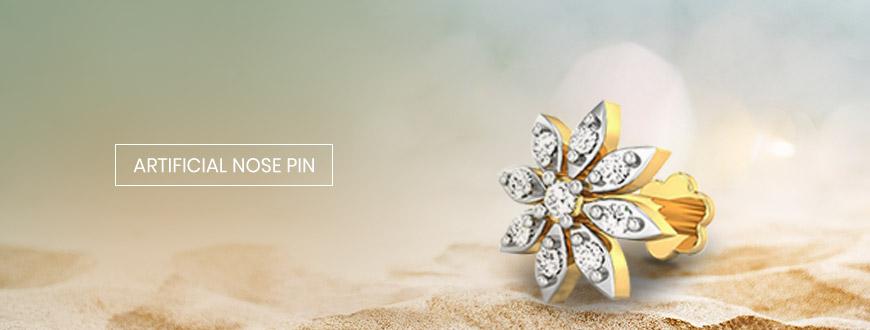Kalyan Wiki

Artificial Nose Pin
Artificial nose pins are broadly classified into nose rings and septum rings. Nose rings are further classified based on the differences in embellishments and regions of acceptance. They come in different shapes; ones which can be worn with or without piercing, the most prominent one being the Maharashtrian Nath nose pins that come in a cashew nut shape, Gold plated and beautifully garnished with Pearls and Diamonds. This nose pin is usually worn during festivals and other important functions. and goes well with traditional outfits. Bridal nose pins(Dulhan Nath) or Nathani are ideal for marriage functions of Rajasthani, Gujarati and Marathi families. This nose pin consists of a big loop with stones or pearls beautifully paired with the nose chain and extended from the nose to the hair. It is one of the components of Solah Shringar, that is, the 16 adornments of the bride.
Nathuri nose pin is a lighter version of Nathani, preferred by Bengali women. Nathuri, which consists of a ring with a small movable bead attached to it, lacks the embellishment of stones found in Nathani.
Mukkuthis are traditional nose rings, in swan or lotus designs, worn by women in Tamil Nadu. It is referred to as Palakka in Kerala. They are mostly studded with topaz or diamonds.
There are primarily three groups of nose rings that form part of traditional and modern approaches, mostly non-piercing and best suited for women in traditional and western wear. The first among these is the American type nose rings. These types of nose rings are always in high demand as they substitute real Diamonds.
Oxidised nose pins are the second type of non-piercing nose pins, also referred to as Tribal nose pins, namely Oxidised Silver plated or German Silver Plated nose clip. They are handcrafted in Silver material, are lightweight, anti-allergic and adjustable to the size and shape of the nose.
The third type is Sania Mirza nose pins, commonly preferred by teenagers; they can be used as earrings too.
The septum ring is usually worn between two nostrils, and its modern designs are derived from rings prevalent among tribal people.This is widely popular among youngsters, and are usually made in Sterling Silver.







